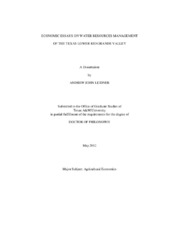| dc.description.abstract | The study area for this dissertation is the Texas Lower Rio Grande Valley (Valley). The overarching theme is water and includes regional water management, water management institutions, and water supply decision-making as it relates to community well-being and public health.
The first essay provides a description of a control model developed for the management of a municipal water supply system in the context of public health and waterborne illnesses issues. The most beneficial disease-management strategy is found to depend on the community's levels of infected population, water services, and budget. The model is numerically parameterized using data drawn from Hidalgo County in the Valley. Greater capital depreciation rates and shorter planning horizons contribute to lower levels of community well-being, which is measured as the present value of damages from disease infection levels. Reductions in community well-being are greatest when greater capital depreciation rates are combined with shorter planning horizons.
The second essay provides an overview of the organizations, institutions, policies, and geographic particulars of the region's water management system and the region's water market. Demand growth for potable water and a relatively-fixed supply of raw water are reflected in increasing prices for domestic, municipal, and industrial (DMI) water rights. The market is characterized by rising prices and the transfer of water from lower-value to higher-value uses. Some reasons for the market's functionality are due to minimal return flows to the Rio Grande (River) occurring throughout the Valley, and the monitoring and enforcement efforts of the Rio Grande Watermaster Program.
The final essay is a presentation of a hydroeconomic model to study regional allocation of water resources across the municipal and agricultural sectors of several counties in the Valley. Results indicate that anticipated population growth will increase demand for municipal water and will motivate the transfer of water from the agricultural sector to the municipal sector and the further development of brackish desalination of groundwater. Population density scenarios indicate greater population density is associated with a greater level of agricultural production and reduced revenue to agriculture from land and water-right sales. On balance, climate change scenarios with population increases to 2060 are associated with fewer acres farmed, cropping pattern shifts to higher-value crops, and increasing irrigation requirements.
Since the study area for this dissertation is encountering a variety of challenges that are related to environmental conditions, institutions, demographics, and health, this dissertation may provide guidance to the broader water-management community and to other locations, where these challenges are also occurring. | en |


